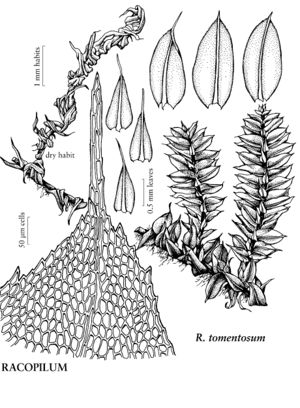Racopilaceae
Plants medium-sized, in creeping mats, dark green. Stems short to elongate, subpinnate or irregularly branched, branches spreading, short, densely tomentose proximally; axillary hairs of 5 cells, basal cell short, brownish. Leaves usually dimorphic, in 4 rows, twisted-contorted when dry, spreading-erect when moist; lateral leaves in 2 rows, larger; dorsal leaves in 2 rows, usually much smaller; oblong-ovate [ovate-acuminate]; margins toothed distally, unbordered [bordered]; apex broadly acute [rounded]; costa single; medial laminal cells quadrate to rhomboidal, smooth [1-papillose]. Sexual condition [dioicous or monoicous] autoicous or synoicous; perigonia gemmiform, leaves small, apex long-awned; perichaetial leaves differentiated. Seta single or rarely 2 per perichaetium, elongate, smooth. Capsule exserted, curved [straight]; operculum beaked or rostrate; peristome double; exostome cross striolate proximally, slender and papillose distally; endostome basal membrane high, papillose, cilia present or absent. Calyptra cucullate or rarely mitrate, hairs usually few to many, long, delicate. Spores smooth [rough].
Distribution
Nearly worldwide, primarily tropical and subtropical regions. The second genus in Racopilaceae is Powellia Mitten with six Asian species.
Discussion
Genera 2, species ca. 70 (1 in the flora).
The second genus in Racopilaceae is Powellia Mitten with six Asian species.
Selected References
Lower Taxa
Illustrations
| Family ⠉ | Taxon | Illustrator ⠉ | |
|---|---|---|---|
 | Racopilaceae | Racopilum tomentosum | Patricia M. Eckel |